 Quaker Farm Home
Quaker Farm Home
Contact & Visitor Info
Guest Speaker Info
Raw Honey
Free Range Eggs
Quaker Soaps
Wool & Fiber
Grass fed Lamb & Mutton
Buff Orpington
Chickens
Border Leicester & Cotswold
Sheep
Collie Dogs
Sustainable Living Workshops
Learn more about life
on the farm!
Click here to read
Quaker Anne's
Children's Stories
 Stories include:
Stories include:
How Bees Make Honey
A Chicken is Born
A Haircut for Sheep
A Baby Horse is Born
A Baby Goat is Born
Lassie Saves a Lamb
|
If this site has been helpful to you, please
donate to help support it.
Making Maple Syrup
Tapping maple trees and making maple syrup at Quaker Farm.
by Quaker Anne
Note: This began as an instructional essay for the Quaker Pantry & Kitchen pages, but we realized that
much of the material could be of interest to children too -
thus, the cross-over!
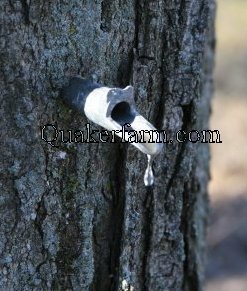
Maple Syrup Fact: Maple syrup production is the oldest agricultural
enterprise in the United States. The State of Michigan ranks 6th in the nation for maple syrup production and
it is the first farm crop harvested in Michigan each year.
At Quaker Farm, we tap the few sugar maple trees that grow here.
Ours is not a commercial operation. We make syrup for our own use and to give away
as gifts to our family and friends.
This has been a seasonal tradition here for years, one that made a very good home schooling project
for our children when they were young.
When I was a little girl growing up in Maine, our family
tapped trees and took part in the long tradition of the New England sugar season. Those memories are
fond ones, and we enjoyed
teaching those skills and handing them down to the next generation.
Now, we want share our experiences with others to provide a resource for
making maple syrup on a small scale for families or home schooling groups who would like to try this
interesting and historically rich project.
Maple syrup is made only during a few weeks in early spring. It is done by tapping sugar maple trees
to collect sap. The sap of the sugar maple tree tastes slightly sweet. It has a high sugar content (for sap) ranging from one
to four percent. When it is boiled down,
it turns
into maple syrup. But this is no small endeavour - it takes approximately 40 gallons of sap to make
just one gallon of maple syrup!
The early American pioneers tapped maple trees as an important source of sugar.
Maple syrup and maple sugar were commonly used back then, as was honey. There was no white sugar to be had
in those days and when the time came that it became available, it was too expensive for most settlers to purchase.
Pioneers, used wooden buckets
to collect
sap from the trees. It had to be gathered by hand several times
a day and through the night. If a large maple grove was being harvested, they poured those buckets of sap into a
large container on a horse drawn sled or wagon
where it was then pulled to a large kettle positioned over a big
open fire. There the sap was poured into the kettle to be boiled down into maple syrup and later, maple sugar.
Interesting historical note about Quakers: It would seem that in about 1788, Quakers promoted a "buy local" ideal out of
a sense of social justice. According to a historical time line found at the Massachusetts Maple Producers
Association web site:
in 1788 Quakers promoted the manufacture and use of maple sugar as an alternative to West Indian
cane sugar production with slave labour.
Today, professional maple syrup producers usually tap large groves or groups of maple trees
that are called a sugarbush, or maple orchard. Only a few still use buckets, usually made of metal or plastic instead of wood. Most run hoses like a pipeline
between the trees to collect the sap together and run it into one large
container. Then it is taken to a large evaporation unit to be processed.
Hobbyists tapping just a few trees, still use the bucket method with either plastic or metal pails.
A Quaker Hill Farm, sugar season usually begins in early to mid 3rd month. We get ready for our
annual harvest of the maple trees in 1st and 2nd months by gathering our supplies together and being ready
for the spring thaw.
Sugar weather only lasts a few weeks and there is no specific time to begin to tap trees. The season starts, begins and ends slightly
differently every year. We live 45 minutes south of the 45th parallel, and given our weather patterns, we expect the season
to start in March.
Nature gives us clues as to
when the time is
right. For instance, the weather warms up a bit, icicles drip, snow begins to melt, birds chatter, crows call and spring just feels
like its in the air. Sap starts to flow when the days are mild (not warm) and the temperature still dips below freezing at night. As a child, I
looked anxiously for "sugar snow" in the spring - those big fat fluffy snowflakes that would quietly fall and accumulate just a
little - that was a sure
sign that the sugar season had arrived. We watch for something similar even today.
It takes up to 40 years for a baby maple tree to grow large enough to tap. Once it is large enough, a maple tree will produce sap for
more than 100 years. Tapping does not hurt the tree or endanger its health in any way. People who tap trees greatly respect and take
good care of them. Maple trees - as all trees - are a great blessing!
A maple tree chosen to tap must be healthy and at least 10 inches in diameter. A small tree and can host 1 tap. A very large maple tree can
host 3 or 4 taps. Throughout the 4 week season, each tap will produce about ten gallons of sap - enough to make about one quart of syrup!
Tapping a Maple Tree
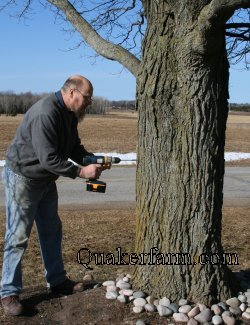 To tap a tree, drill a 7/16 diameter hole, waist hight and level, about 1 1/2 to 2 inches deep through the bark of a maple tree. The site should
be well away from any previous tap holes. Do not drill at an angle as it will cause problems with sap collection.
To tap a tree, drill a 7/16 diameter hole, waist hight and level, about 1 1/2 to 2 inches deep through the bark of a maple tree. The site should
be well away from any previous tap holes. Do not drill at an angle as it will cause problems with sap collection.
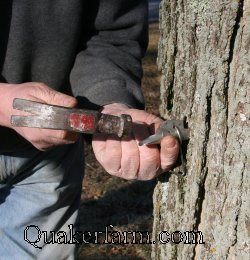 A metal spout (also called a "spile"), with a hook hanger,
is gently but
firmly tapped into the hole.
A metal spout (also called a "spile"), with a hook hanger,
is gently but
firmly tapped into the hole.
Do not tap the spile into the tree so hard that it splits the bark because the sap will
drain down the
crack and onto the ground missing the collection bucket or jug all together.
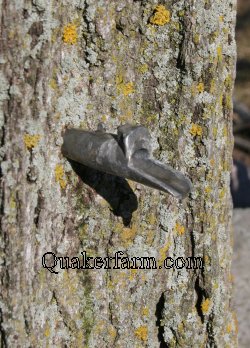 Once the tap is properly installed, sap will immediately start dripping through it. It is now time to hang the bucket onto the spile.
Once the tap is properly installed, sap will immediately start dripping through it. It is now time to hang the bucket onto the spile.
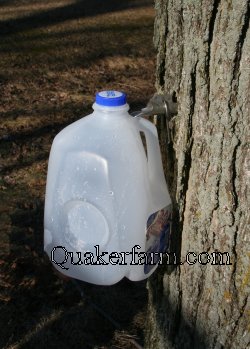 The bucket is hung from from the hook on the spout and covered to protect the sap from
rain, snow and debris. A plastic milk jug with a small hole cut for the tap to fit through
can be used and works well for this project.
When the trees have been tapped the sap will drip from the spout into the pail or milk jug.
The bucket is hung from from the hook on the spout and covered to protect the sap from
rain, snow and debris. A plastic milk jug with a small hole cut for the tap to fit through
can be used and works well for this project.
When the trees have been tapped the sap will drip from the spout into the pail or milk jug.
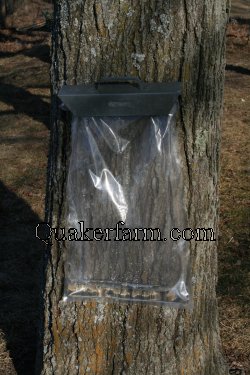 It does not take long for sap to fill a container. Along with milk jugs, we also use sap
bag
containers to collect sap in. After only two hours, this is the amount of sap (shown in the picture) that accumulated on a good
sap-flow day.
It does not take long for sap to fill a container. Along with milk jugs, we also use sap
bag
containers to collect sap in. After only two hours, this is the amount of sap (shown in the picture) that accumulated on a good
sap-flow day.
The amount of sap flow will vary with the
weather.
Sap flows best when nights are freezing and days are
mild. Temperatures must alternate to start the sap moving in the trees. If there is a prolonged period of warmth or freezing, the sap will
stop flowing.
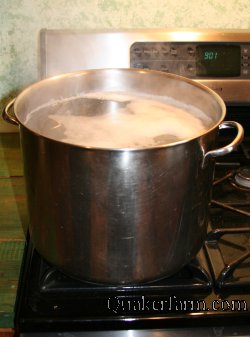 Once collected, the sap must be evaporated right away because only fresh sap makes quality syrup.
Sap
tends to sour like milk
if left standing too long.
Once collected, the sap must be evaporated right away because only fresh sap makes quality syrup.
Sap
tends to sour like milk
if left standing too long.
We evaporate our sap in large stainless steel cooking kettles. It is better to do this in a flat evaporation
pan where more surface is exposed for quicker evaporation - but this has always worked well enough for us.
It is not necessary to filter the sap before evaporating it unless there is an excessive amount of debris such as bark
or leaves. Filtering is generally done once maple syrup has been achieved.
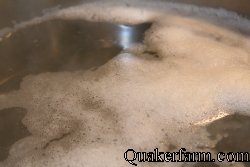 Heat the sap to boiling point then turn the heat down to a light simmer. When working with a full pot, be careful that the sap
does not foam
over the sides. A little bit of butter wiped along the top edge of the pot helps to prevent the sap from foaming over.
Check the pot frequently, stirring is not necessary.
Heat the sap to boiling point then turn the heat down to a light simmer. When working with a full pot, be careful that the sap
does not foam
over the sides. A little bit of butter wiped along the top edge of the pot helps to prevent the sap from foaming over.
Check the pot frequently, stirring is not necessary.
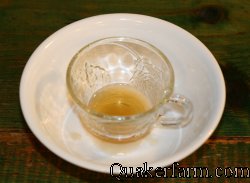 The evaporation process takes many hours depending on the volume of sap.
We process sap in 20 gallons batches and expect a finished volume of about 2 quarts. This is a rough
estimate, the
amount can
vary greatly but this gives you an idea.
The evaporation process takes many hours depending on the volume of sap.
We process sap in 20 gallons batches and expect a finished volume of about 2 quarts. This is a rough
estimate, the
amount can
vary greatly but this gives you an idea.
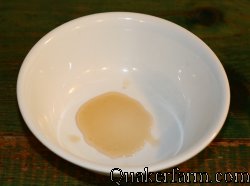 The steam of this evaporation has a uniquely warm and comforting smell quite distinguished
to itself. Enjoy it to the full as it won't come around again for a whole year! The steam of this evaporation has a uniquely warm and comforting smell quite distinguished
to itself. Enjoy it to the full as it won't come around again for a whole year!
Once enough liquid has evaporated, the sap will turn a pale amber color and begin
to resemble syrup. Yes, dip a spoon and taste - unbelievably delicious, yum!!
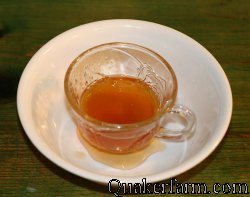 There are tools which can be purchased to help you determine when the time is exactly right and the syrup is "ready".
We actually don't use them. Sometimes out of curiosity, we employ a candy thermometer but I much prefer to rely on the
techniques passed down to me as a child from the old-timers, staunch New-Englanders many of whom were
in their 80's and 90's, who did not use gauges of any kind.
They made maple syrup the old
fashioned way,
as their predecessors before them did, by developing an eye for color and consistency, and by looking, tasting
and "spooning" as they called it.
There are tools which can be purchased to help you determine when the time is exactly right and the syrup is "ready".
We actually don't use them. Sometimes out of curiosity, we employ a candy thermometer but I much prefer to rely on the
techniques passed down to me as a child from the old-timers, staunch New-Englanders many of whom were
in their 80's and 90's, who did not use gauges of any kind.
They made maple syrup the old
fashioned way,
as their predecessors before them did, by developing an eye for color and consistency, and by looking, tasting
and "spooning" as they called it.
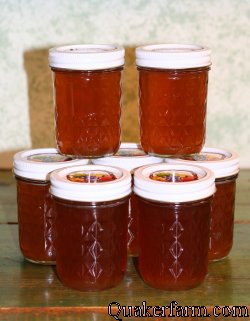 Syrup that is ready to pour has a unique
unmistakable character and while it is tricky to "catch" the moment just right,
it is a notable accomplishment for syrup cooked
too long granulates and becomes maple sugar. But that is a lesson for another time!
Syrup that is ready to pour has a unique
unmistakable character and while it is tricky to "catch" the moment just right,
it is a notable accomplishment for syrup cooked
too long granulates and becomes maple sugar. But that is a lesson for another time!
We pour our syrup through a filter into small glass containers. They not only make lovely
gifts, they are also a nice
serving size for just a meal or two. That way the syrup is always fresh and you don't have a large
open container left over to refrigerate.
Now, I want to comment about the wonder of this. Delicious maple syrup comes from a tree -
a tree. God's creation is magnificent in so very many ways and this is just a mere sample of His
thoughtfulness towards us. Our heavenly Father surrounds us with His glory through the wonders of creation
all around us - great and small. Those wonders are almost a manifestation of His embrace, and are
absolutely the certain evidence of His
magnificence and creative design authorship. In just this case alone, God created the sugar maple
tree in such a way that it can provide food for man in the form of sugar. It is available for just the little work
it takes to harvest it and nothing need be added to it for it is perfect just the way it is.
Wonderful maple syrup and sugar, so pure
and natural, such a blessing and provision from the great bounty God has
provided for mankind. Every time thee tastes the pure product, remember, it came from a tree
designed by our Creator because He loves
us, God loves you, and He created the earth, this beautiful place, for us to live on and enjoy. Always respect that,
always thank Him,
in the name of our Saviour Jesus Christ, for it and the great many blessings experienced in thy life from the moment thee
awakes in the morning until thee returns to bed at night.
This day, as I write, birds are singing and flitting among the branches of the trees outside
my room - the trees that are their home are the same ones being tapped
for sap to make maple syrup. Each bird song expresses the joy that I feel for springtime and
the
delicious maple syrup we make.
Each moment a blessing from God.
Every good gift and every perfect gift is from ...the Father. James 1:17
Snow Sugar Candy
This spring-time delicacy has been a traditional candy favorite at maple sugar houses
for over
200 years. It was also known as "leather aprons" or
"leather britches", due to its chewy, leathery consistency. A tradition started in New England,
it is called
sugar-on-snow. This fun maple candy can easily be made at home and makes a really interesting
project for children, especially when studying early American history. A real home schoolers favorite!
Click here to learn all about it and make some of your own!
If this site has been helpful to you, please
donate to help support it.
Return to Quaker Anne's Children's Stories
Return to Quaker Hill Farm Homepage
We thank thee for visiting our site and welcome thee will visit again soon.
"The Lord bless thee and keep thee...."
- Numbers 6:24

|